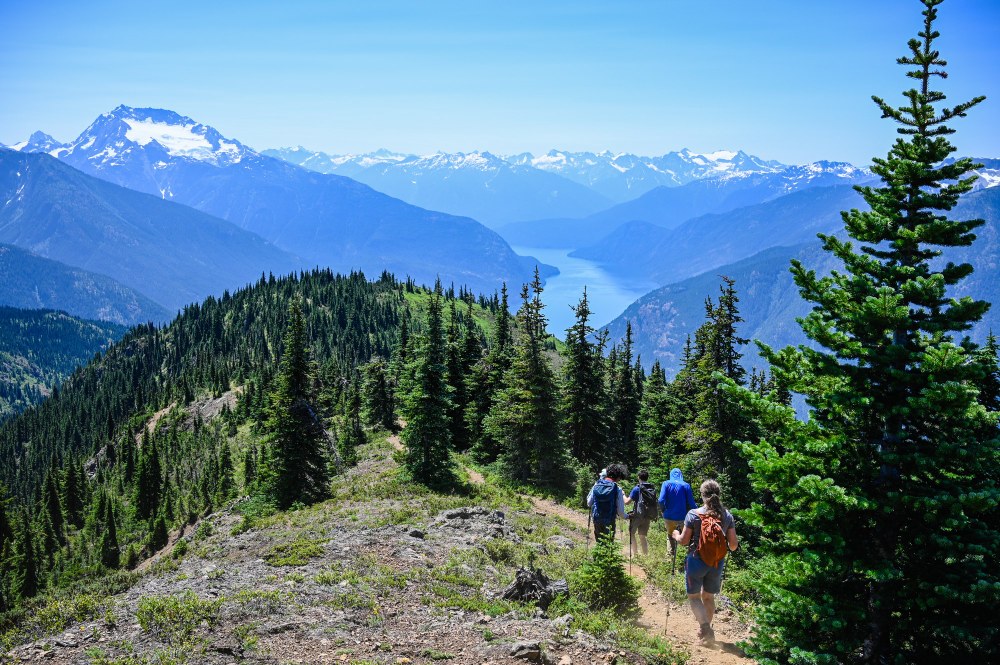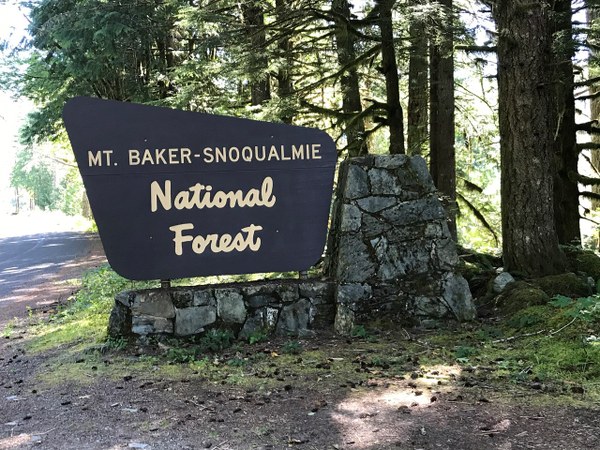
Public lands are central to The Mountaineers experience. Playing host to our programs and activities, these parks, trails, waterways, and other open spaces connect us to nature and provide many public health benefits. North Cascades National Park, Deception Pass State Park, and Tiger Mountain State Forest are just a few of Washington’s popular public lands. Public lands are managed for different conservation objectives and recreational uses, but public access for recreation remains a common thread that defines these places.
Through our conservation and advocacy work, we strive to influence policy and management decisions on public lands, to conserve natural landscapes and the recreational opportunities they provide. Most of our work focuses on management of federal public lands, but we also engage around policy and planning related to high priority state-managed recreation lands. Time and again, our members speak up for the protection and funding of our public lands.
With so many types of public land, it can be hard to make sense of their different uses, access permits, and regulations. Knowing and understanding the basics of public lands help you optimize your outdoor experiences and better conserve our region’s landscapes for future generations of Mountaineers.
What are public lands?
Public lands are areas of land and water owned collectively by the American public and managed by government agencies for conservation, recreation, and commercial uses. Despite varying management priorities, all Americans have a right to access these lands and have a say in how they are managed. Various government agencies work collaboratively to manage these landscapes, including the wildlife and natural resources found within, as well as visitation and recreational use. This can lead to trails and recreation areas that stretch across multiple types of public lands.
Public Lands are Native Lands
U.S. public lands trace back to 19th century westward expansion, a time synonymous with the taking of lands from Native peoples. Today, our society is still grappling with the uncomfortable truth that public lands were created through the forced removal of Indigenous peoples from their traditional homelands. These peoples have lived here since time immemorial, and their descendents are still here maintaining cultural and spiritual connections to areas now managed as public lands.
Native tribes have long sought increased recognition, respect, and collaboration from federal and state government agencies. Today, land managers at all levels of government are increasingly taking steps to partner with Tribal Nations to co-manage public lands and their natural resources. We’ve also seen progress in changing standard narratives to reflect this troubling history in the stories told about public lands by incorporating more Indigenous stories and perspectives.
It’s important for recreationists to remember that while we might view public lands as spaces for play, these lands carry different significance for the cultures and livelihoods of Native Tribes - the first stewards of these lands and waters.
 Mt. Baker-Snoqualmie National Forest. Photo by Conor Marshall.
Mt. Baker-Snoqualmie National Forest. Photo by Conor Marshall.
Different types of federal public lands
Federal public lands are probably most recognizable to the average outdoor enthusiast, but public lands come in many shapes and sizes. Most federal lands are managed by the National Park Service, U.S. Forest Service, U.S. Fish and Wildlife Service, and the Bureau of Land Management. These agencies balance different conservation missions and management considerations, leading to varying recreational opportunities on their lands.
National Parks
While you’re probably familiar with the three iconic national parks in Washington - North Cascades, Mount Rainier, and Olympic - the National Park Service also manages national historical parks, monuments, and recreation areas. The National Parks System preserves more than 85 million acres of unique natural and cultural resources and provides opportunities for the public to enjoy them. National parks can only be designated by Congress through the legislative process. Land managers generally prohibit extractive industries like mining and oil drilling on and near national parks. Parks are likely to include Wilderness areas and require visitors to engage in lower-impact recreational activities like hiking. While visits to national parks are special, there are so many other public lands awaiting your adventure.
National Forests
The U.S. Forest Service manages about 193 million acres of our nation’s forests for recreation, livestock grazing, timber production, and conservation of fish and wildlife habitat. Washington is home to five national forests: the Colville, Gifford-Pinchot, Mount Baker-Snoqualmie, Okanogan-Wenatchee, and Olympic. National forests can be great recreational alternatives to national parks, as they generally see lower visitation. They provide the greatest diversity of recreational uses on public lands - you can bike, hunt, fish, and ride horses and off-road vehicles on national forest land.
National Wildlife Refuges
These lands are managed by the U.S. Fish and Wildlife Service to conserve and protect plants and wildlife and their habitat for the benefit of the American people. Refuge managers prioritize wildlife-dependent recreation like wildlife watching, fishing, and hunting. Biking is sometimes permitted on designated roads and trails where appropriate. A local example of a popular wildlife refuge is the Billy Frank Jr. Nisqually National Wildlife Refuge, located near Olympia, where the Nisqually river flows into Puget Sound and provides critical habitat for native fish, birds, and wildlife - it’s definitely worth a visit.
Bureau of Land Management Lands
Bureau of Land Management (BLM) lands can be found throughout 12 western states. Similar to National Forests, BLM lands are managed for many uses, including resource extraction. BLM lands generally host more grazing, mining, and oil and gas development than other types of public lands. While these lands lend themselves to many recreational uses (including camping and climbing), higher-impact activities like off-road vehicle use is common. Eastern Washington is home to several BLM recreation areas, including the Juniper Dunes Wilderness in Franklin County. The BLM also manages San Juan Islands National Monument.
Federal Conservation Designations
Wilderness Areas
“Wilderness” is the highest level of protection federal public lands can receive. This designation preserves the wild character of a landscape and ensures that it remains free from development. Like national parks, wilderness areas can only be established by an act of Congress. We have 31 designated wilderness areas in Washington State. The 2014 expansion of the Alpine Lakes Wilderness is the most recent example of new Wilderness designation in Washington.
National Monuments
National monuments protect areas containing “objects of historic or scientific interest” and can be managed by the National Park Service, U.S. Forest Service, or other agencies. The President has the authority to protect natural and cultural resources through National monument designation using the Antiquities Act. Congress can also create national monuments by passing legislation - Mount St. Helens National Volcanic Monument in Southwest Washington is a prime example of this process. Some national parks were first preserved as national monuments, and while many monuments don’t garner the same visitation as national Parks, try one out - you could be visiting a future national park!
Wild and Scenic Rivers
Typically established by Congress, the “wild and scenic” conservation designation safeguards waterways from dams and other industrial projects affecting river flow. Think of it as a wilderness designation specifically for waterways. The Middle Fork Snoqualmie and Pratt rivers are two examples of wild and scenic rivers in Washington that make great destinations for paddling and other water-based recreation.
State and Local Public Lands
State-managed Public lands
Here in Washington, we’re fortunate to have 6.5 million acres of state-managed parks and public lands. State parks, wildlife areas, natural resource conservation areas, and other recreation lands are popular for camping and generally host a wide range of activities. Many of these lands are open to fishing, hunting, biking, climbing, and wildlife watching. Some state wildlife and conservation areas are more restrictive to recreation. The Mountaineers frequently utilize state public lands - including the Frenchman’s Coulee climbing area at Columbia Basin Wildlife Area in central Washington - for our programs and activities.
Local/Regional Conservation Areas
Often the parks or public lands closest to where we live are managed by a city or county parks department. For example, Cougar Mountain is a regional wildland park and popular hiking destination managed by King County. These types of open spaces attract more local users and deliver natural recreation experiences at little to no cost. They’re also more likely to be accessible by public transit and to allow pets.
How are Public Lands Funded?
Federal land management agencies like the U.S. Forest Service receive annual funding, or “appropriations,” from Congress to carry out their mission and manage their agency's suite of public lands. Special efforts like the Great American Outdoors Act can provide an infusion of resources to support a thriving system of public lands.
In many cases, our state and local tax revenue funds the maintenance and operations of public lands. This support can look very different at the federal versus state and local level. States and localities also rely on voter-approved park bonds to acquire new land and finance projects to restore park and recreation resources.
Annual passes like the federal America the Beautiful Pass and Washington’s Discover Pass help fund public lands. Other fees, permits, and special funding mechanisms like novel license plates also support these areas.
How You Can Protect Public Lands
Our Mountaineers conservation and advocacy program webpages are a good place to start. Next, check out our Protecting Public Lands 101 e-course to learn more and test your knowledge of public lands - you’ll earn the course badge in the process.
Sign up for our monthly conservation newsletter Conservation Currents to receive updates on our public lands and opportunities to advocate for them, like commenting on proposed land management plans and actions.
Looking for something a little more hands-on? Consider participating in an upcoming stewardship activity to give back to public lands in our region.
Look out for future stories in our Conservation 101 blog series to help you unpack the world of conservation and advocacy. In case you missed it, check out the first post in this series, all about advocacy.
 The Mountaineers
The Mountaineers